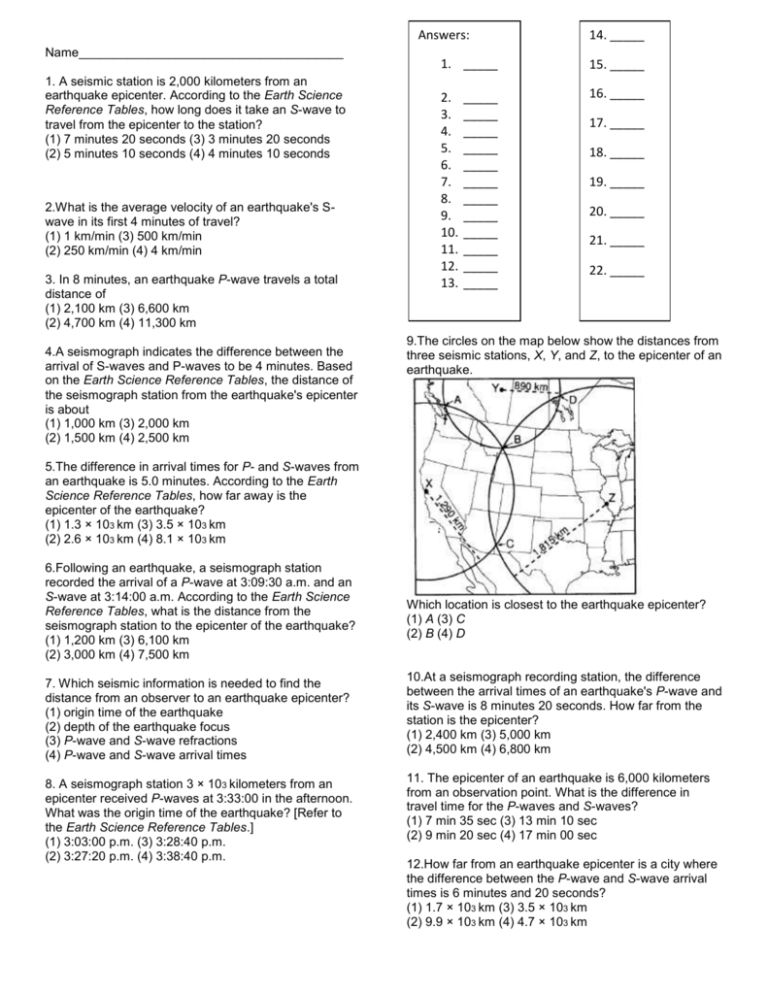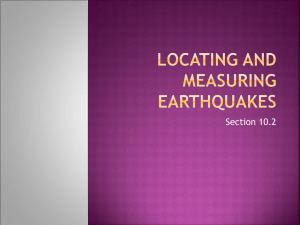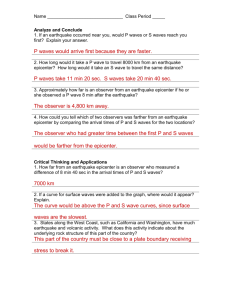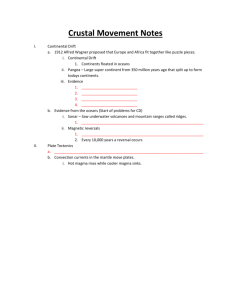Earthquake Questions worksheet
advertisement

Answers: Name______________________________________ 1. A seismic station is 2,000 kilometers from an earthquake epicenter. According to the Earth Science Reference Tables, how long does it take an S-wave to travel from the epicenter to the station? (1) 7 minutes 20 seconds (3) 3 minutes 20 seconds (2) 5 minutes 10 seconds (4) 4 minutes 10 seconds 2.What is the average velocity of an earthquake's Swave in its first 4 minutes of travel? (1) 1 km/min (3) 500 km/min (2) 250 km/min (4) 4 km/min 3. In 8 minutes, an earthquake P-wave travels a total distance of (1) 2,100 km (3) 6,600 km (2) 4,700 km (4) 11,300 km 4.A seismograph indicates the difference between the arrival of S-waves and P-waves to be 4 minutes. Based on the Earth Science Reference Tables, the distance of the seismograph station from the earthquake's epicenter is about (1) 1,000 km (3) 2,000 km (2) 1,500 km (4) 2,500 km 14. _____ 1. _____ 15. _____ 2. 3. 4. 5. 6. 7. 8. 9. 10. 11. 12. 13. 16. _____ _____ _____ _____ _____ _____ _____ _____ _____ _____ _____ _____ _____ 17. _____ 18. _____ 19. _____ 20. _____ 21. _____ 22. _____ 9.The circles on the map below show the distances from three seismic stations, X, Y, and Z, to the epicenter of an earthquake. 5.The difference in arrival times for P- and S-waves from an earthquake is 5.0 minutes. According to the Earth Science Reference Tables, how far away is the epicenter of the earthquake? (1) 1.3 × 103 km (3) 3.5 × 103 km (2) 2.6 × 103 km (4) 8.1 × 103 km 6.Following an earthquake, a seismograph station recorded the arrival of a P-wave at 3:09:30 a.m. and an S-wave at 3:14:00 a.m. According to the Earth Science Reference Tables, what is the distance from the seismograph station to the epicenter of the earthquake? (1) 1,200 km (3) 6,100 km (2) 3,000 km (4) 7,500 km 7. Which seismic information is needed to find the distance from an observer to an earthquake epicenter? (1) origin time of the earthquake (2) depth of the earthquake focus (3) P-wave and S-wave refractions (4) P-wave and S-wave arrival times 8. A seismograph station 3 × 103 kilometers from an epicenter received P-waves at 3:33:00 in the afternoon. What was the origin time of the earthquake? [Refer to the Earth Science Reference Tables.] (1) 3:03:00 p.m. (3) 3:28:40 p.m. (2) 3:27:20 p.m. (4) 3:38:40 p.m. Which location is closest to the earthquake epicenter? (1) A (3) C (2) B (4) D 10.At a seismograph recording station, the difference between the arrival times of an earthquake's P-wave and its S-wave is 8 minutes 20 seconds. How far from the station is the epicenter? (1) 2,400 km (3) 5,000 km (2) 4,500 km (4) 6,800 km 11. The epicenter of an earthquake is 6,000 kilometers from an observation point. What is the difference in travel time for the P-waves and S-waves? (1) 7 min 35 sec (3) 13 min 10 sec (2) 9 min 20 sec (4) 17 min 00 sec 12.How far from an earthquake epicenter is a city where the difference between the P-wave and S-wave arrival times is 6 minutes and 20 seconds? (1) 1.7 × 103 km (3) 3.5 × 103 km (2) 9.9 × 103 km (4) 4.7 × 103 km 13. At which epicenter distance is the difference in arrival times between P-waves and S-waves greatest? (1) 1,000 km (3) 5,000 km (2) 3,000 km (4) 7,000 km 14. A P-wave reaches a seismograph station 2,600 kilometers from an earthquake epicenter at 12:10 p.m. According to the Earth Science Reference Tables, at what time did the earthquake occur? (1) 12:01 p.m. (3) 12:15 p.m. (2) 12:05 p.m. (4) 12:19 p.m. `Base your answers to questions 19 & 20 on the Earth Science Reference Tables and the map below. The map shows seismograph recording stations at locations A, B, and C. Location D is an earthquake epicenter. The distances from locations A and B to this epicenter are given in kilometers. 15. An earthquake occurred at 5:00:00 a.m. According to the Earth Science Reference Tables, at what time would the P-wave reach a seismic station 3,000 kilometers from the epicenter? (1) 5:01:40 a.m. (3) 5:05:40 a.m. (2) 5:04:30 a.m. (4) 5:10:15 a.m. 16. A seismographic station determines that its distance from the epicenter of an earthquake is 4,000 kilometers. According to the Earth Science Reference Tables, if the P-wave arrived at the station at 10:15 a.m., the time of the earthquake's origin was (1) 10:02 a.m. (3) 10:10 a.m. (2) 10:08 a.m. (4) 10:22 a.m. Base your answers to questions 17 and 18 on the Earth Science Reference Tables and the diagram below. The diagram shows a method used to locate the epicenter of an earthquake. 19. At which location is the arrival-time difference between the P-wave and the S-wave greatest? (1) A (3) C (2) B (4) D 20. Approximately how long did the S-wave take to travel from the epicenter to location A? (1) 11 min 15 sec (3) 5 min 20 sec (2) 9 min 35 sec (4) 4 min 20 sec 21.A seismograph station records a travel time difference of 5.5 minutes between the P-waves and Swaves of an earthquake. How far is the seismic station from the epicenter of this earthquake? (1) 1.5 × 103 km (3) 3.0 × 103 km (2) 2.0 × 103 km (4) 4.0 × 103 km 22. The seismogram below shows the arrival times of Pand S-waves from a single earthquake. According to the Earth Science Reference Tables, how far from the earthquake epicenter was the station that recorded this seismogram? 17. Which location represents the epicenter of the earthquake? (1) A (3) C (2) B (4) D 18. If the distance from the epicenter to station 2 is 3,500 kilometers, what is the approximate difference in the arrival times of the P-waves and S-waves at station 2? (1) 1 minute 40 seconds (3) 6 minutes 20 seconds (2) 5 minutes 10 seconds (4) 11 minutes 30 seconds (1) 1.5 × 103 km (3) 3.0 × 103 km (2) 2.5 × 103 km (4) 4.0 ×103 km








